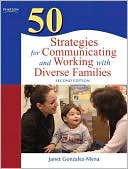50 Strategies for Communicating and Working with Diverse Families
Search in google:
50 Early Childhood Strategies for Working and Communicating with Diverse Families is a practical and easy to use book. It presents key concepts, discusses them in research-based, accessible prose, and provides useful strategies to facilitate communication and collaboration. The book focuses on family-centered care and education for young children and emphasizes partnering with families. Many of the strategies in this book address ideas about how to create a climate of trust by communicating in a collaborative way. The goal is to create inclusive programs that respect and honor differences in families and individuals. Teachers will love the fifty short chapters with information they can apply immediately. At the heart of all these strategies lies the welfare of the child.FEATURES: Emphasizes the importance of partnerships between teachers and family members.Stresses the integral components of communication between diverse families and teachers or administrators.Raises the important issue of respecting the various diversities and cultures that exist in today's classrooms. Reader-friendly writing style and the alphabetic arrangement of the strategies-interesting, understandable, and easy to find what the student or teacher is looking for. Interwoven, cross-referenced strategies-integrity throughout the book as the relationships between the strategies are highlighted; one strategy often mentions several other strategies that pertain to the same subject. Broad coverage: spans ages 0-8 in a variety of different care and education settings-applies to early childhood educators at all levels-not exclusive to Pre-K; also includes child care, but not exclusively. Goes beyond mere parent involvement and education-closely examines how a partnership may include both, but is different from the more common approaches early childhood educators often take to working with parents; promotes a family-centered approach instead of a child-centered one that is common practice. Photos and artifacts illustrate the messages-these visual images are designed to help readers grasp information and enliven the book.New to this Edition!Strategies organized by categories, rather than alphabetically. Emphasis on kindergarten and primary grade teachers. Diversity theme at forefront of strategies. New subjects covered include: working with families to maintain home language, holidays in the classroom, media issues, improving child nutrition, children playing outdoors, and dealing with death in the family.
Normal 0 false false falseSECTION 1 Welcoming Everybody 1 Appreciating all Kinds of Families 2 Working with Immigrant Families 3 Including Families of Children with Special Needs 4 Creating an Anti-bias Environment 5 Respecting all Families including those with Same Sex ParentsSECTION 2 Partnerships with Families 6 Building Partnerships 7 RemovingBarriers to Partnerships 8 Minimizing Competition with Parents 9 Supporting Attachment 10 Considering Authority11 Focusing on Family Strengths12 Helping Parents to be Advocates for their Children13 Encouraging Parents to Become Advocates for all Children 14 Creating a Sense of CommunitySECTION 3 Honoring and Working with Diversity 15 Understanding and Appreciating Cultural Differences 16 Establishing Culturally Responsive Education and Care 17 Working with conflicts around Education and Care Practices 18 Considering Cultural Differences in Guidance and Discipline 19 Working with Families around what You Believe are Harmful Practices 20 Thinking about Differing Ideas Related to How Children Learn 21 Managing ConflictsSECTION 4 Family Participation and Education 22 Considering Family Participation 23 Including Parents in the Classroom or Center 24 Focusing on Fathers 25 Taking a Transformative Approach to Parent Education 26 Working with Parents around Holiday Issues 27 Exploring Parents’ Role on Decision-Making Boards and CouncilsSECTION 5 Communication 28 Creating Environments for Communication 29 Empowering Self and Others 30 Communicating through Writing 31 Holding Ongoing Conversations with Families 32 Looking at Nonverbal Communication across CulturesSECTION 6 Meetings and Conferences 33 Meeting Families for the First Time34 Thinking about Meetings in General35 Holding Conferences 36 Considering Cross Cultural Conferences 37 Talking with Families when Concerns AriseSECTION 7 Working with Parents around Specific Issues38 Helping the Child Enter the School or Program 39 Maintaining Home Language 40 Easing Children through Transitions 41 Bringing Nature into Children’s Lives42 Addressing Obesity with Nutrition43 Dealing with Media Issues 44 Maintaining Stability During Divorce45 Coping with a Death in the Family 46 Finding Community Resources and making ReferralsSECTION 8 Challenging Conversations47 Working with Parents who Constantly Complain 48 Working with Parents who Appear Hostile 49 Talking with Parents about Behavior Changes 50 Referring Families for Abuse or NeglectReferencesIndexNormal 0 false false false Normal 0 false false false Normal 0 false false false








